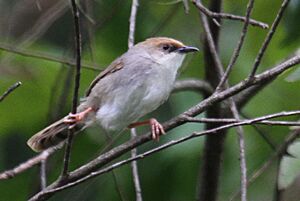Chubb's cisticola facts for kids
Quick facts for kids Chubb's cisticola |
|
|---|---|
 |
|
| Conservation status | |
| Scientific classification | |
| Genus: |
Cisticola
|
| Species: |
chubbi
|
The Chubb's cisticola (Cisticola chubbi) is a small, active bird. It is part of the Cisticolidae bird family. These birds are known for their lively songs and often live in thick bushes. You can find them in parts of Africa, including Cameroon, Kenya, Uganda, and the Albertine Rift montane forests.
Contents
About the Chubb's Cisticola
Chubb's cisticolas are very territorial birds. This means they protect their living space from other birds. They spend most of their time hidden away in dense plants and trees.
Different Types of Chubb's Cisticola
Just like people can have different groups, birds can have different "subspecies." These are groups within a species that have slight differences, often because they live in different areas. There are four known subspecies of Chubb's cisticola:
- C. c. adametzi: Found in southeastern Nigeria and southwestern Cameroon.
- C. c. discolor: Lives around Mount Cameroon in southwest Cameroon. This one is sometimes called the brown-backed cisticola.
- C. c. chubbi: This is the main type, found from eastern DR Congo to western Kenya.
- C. c. marungensis: Lives in the Marungu highlands in southeastern DR Congo.
How They Communicate
Chubb's cisticolas are quite vocal, meaning they sing a lot! They often sing together, which is called duetting or chorusing.
Singing Together
When a male and female sing together, it's called a duet. The male bird usually makes a trilling sound, which is a fast, vibrating note. The female bird makes longer, lower-pitched whistling sounds. These duets are usually done when the birds are very close, less than a meter apart. They can even see each other while singing.
Sometimes, more than two birds sing together in a chorus. Up to five birds might join in! This is most common when the breeding season is ending. Singing alone is very rare for these birds.
Why They Sing
Their songs, especially duets and choruses, are mostly used to defend their territory. It's like saying, "This is our space, stay away!" While singing, they also do dance-like movements. They might move their tails or flap their wings to make snapping noises. They usually sing from high places, like the top of a bush or a tree branch.
Family Life
Chubb's cisticolas are most likely monogamous. This means a male and female bird usually stay together as a pair to raise their young.
Building a Nest
The female bird does most of the work when building the nest. They typically build their nests about 0.5 to 2 meters (about 1.5 to 6.5 feet) above the ground. This helps keep their eggs and chicks safe.
Caring for Eggs
Once the eggs are laid, the female bird takes the main role in incubating them. Incubation means keeping the eggs warm until they hatch.



